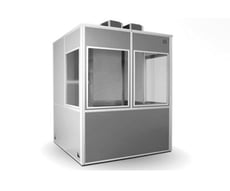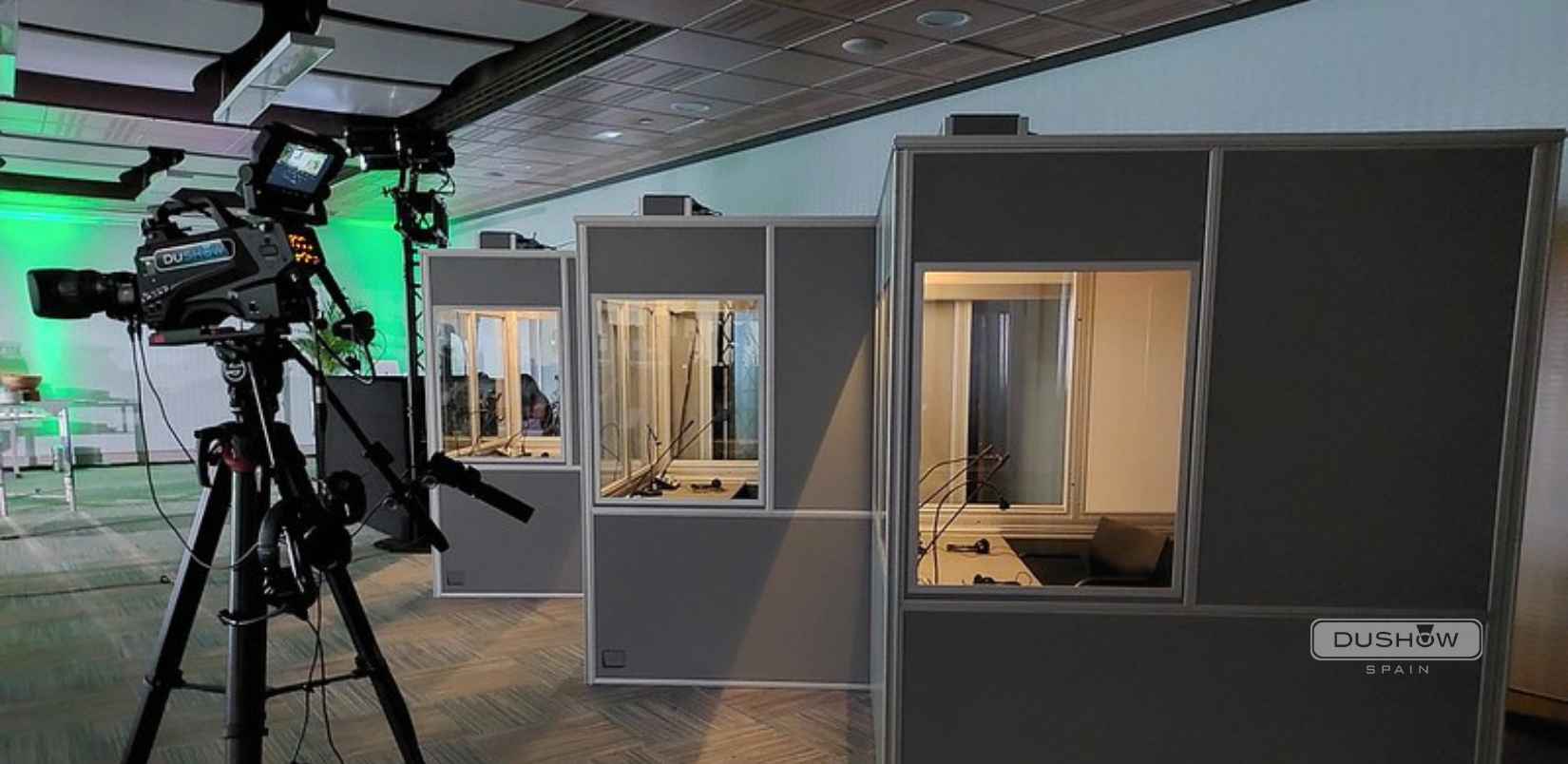Dushow Spain is now Novelty Spain
Simultaneous translation booths: everything you should know to include them in your event
Over the past decades, it has become more common to organize events with international attendees or speakers. In such cases, having one or several simultaneous translation booths is essential if you are seeking to offer an excellent experience to both attendees and the interpreters responsible for the translation.
Do you want to know what a simultaneous translation booth is, the various types and which is the best-suited for your next event? Read on to learn about all of this and more.
If you’d rather enjoy this article in video format, here is the link to watch it on our YouTube channel:
What is a simultaneous translation booth?
It is a small booth containing the equipment necessary for interpreters to perform their jobs in optimal conditions. Their most important features are that they are completely sound-proof and insulated from external noise, comfortable for translators and with ventilation capacity sufficient to ensure health and safety standards. This enables interpreters to fully concentrate on their task. These details and requirements are usually reflected in a certification that not all models qualify for.

Simultaneous translation booths are usually in the same room where the presentation is being g
iven. They are equipped with large windows for interpreters to have a clear, direct view of the speakers. This is important, as non-verbal language can have a real influence on real-time translation.
What is a simultaneous translation booth used for?
Simultaneous translation booths are essential at any event, seminar or congress where individuals who do not speak or understand each other’s languages are to make or listen to presentations. It is an optimal workspace for interpreters to isolate themselves and concentrate on translating the speaker’s words in real time.
The use of such booths is a vital part of getting optimal, high-quality results. In addition to the right level of soundproofing, they are also a space to install the lighting, sound and/or video equipment necessary to provide simultaneous translation. Some of their most important components include:
- Simultaneous translation consoles: this is the piece of electronic equipment necessary to perform the task of interpreting. With them, interpreters can receive and transmit audio signals, connect microphones and headphones, adjust the volume and turn the microphone off and on, in addition to many other functions.
- Interpreting microphone: The consoles are equipped with microphones that can perfectly pick up the translators’ voices, and little else. They give the interpreter the freedom to concentrate on the task at hand while ensuring the quality of the audio signal.
- Interpreter’s headphones: there is a separate headset for each interpreter. Through it, the interpreter receives the audio signal of whoever is speaking through the floor microphone. The quality of the sound, that it be free from interference and that there be no delay are all important factors.
- Transmission system: radio-frequency or infrared transmitters are installed in the room where the event is to be held. They are connected to the simultaneous translation booth. Through them, the audio signal of the simultaneous translation is broadcast.
- Wireless receivers: attendees using the translation system will have a receiver to which headphones are connected. Through them, the audio signal of the simultaneous translation is received from the booth. If more than one language is being translated, the receiver should feature a channel selector.
Most of the time, it is best to have a sound engineer who will be responsible for managing the proper operation of the installation, and troubleshoot any issues that may arise.
Types of simultaneous translation booths
Over the years, different simultaneous translation booth solutions have been developed. Choosing the right one is crucial for the interpreters, who will enjoy a more comfortable setting in which to do their jobs, and for the audience, who will benefit from a higher-quality translation.
A booth not only keeps exterior noise from interfering with the translators’ voices, it also keeps their voices from disturbing the spectators or professionals who may be sitting nearby.
On one hand, there are fixed simultaneous translation booths. The venues where international or large-scale events are usually held usually feature them. They are found in auditoriums, conference rooms, trade fair facilities, etc. They are usually built in a high part of the venue, and are more spacious and comfortable for interpreters than other types of booths.
Then there are portable simultaneous translation booths. They are small modular booths that can be installed in nearly any event space. Portable booths are an excellent solution when fixed booths are not available. They are easy to transport and set up, and they provide the necessary insulation for interpreters to concentrate completely.
Last, today remote simultaneous translation booths have become more important. They are mostly used for on-line events that require simultaneous translation. They can be anywhere in the world. Through them, remote interpreting is possible. In such cases, you will need a fast and reliable internet connection if you want to avoid latency problems.
What is the best option for your event?
In general, the best option is to choose a fixed translation booth. They provide the best workspace, HVAC, work surface, soundproofing and visibility. In short, this option offers the most comfort and therefore, best results.
But it is not always possible to rent a venue that features this type of booth. In these cases, it is best to have a portable simultaneous translation booth. Although they are smaller and not as comfortable, they are truly practical, as they offer good sound-proofing and are easy to install.
Remote interpreting is an alternative that can be deployed when none of the other previous options are possible, for example, on-line events.
At Dushow, we can advise you on the different options, and guide you as you choose the option that offers the best experience for your attendees, since the success or failure of your event always depends on their satisfaction.
This article was first published in Dushow Spain, you can read the original Spanish version here.






